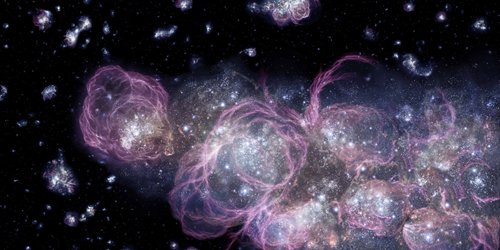Dark Matter at Cosmic Dawn
The profusion of dark matter candidates reflects how easy it is for any of them to explain the current large-scale structure of the Universe. Decisive clues about dark matter’s true nature are more likely to appear at earlier epochs. Unfortunately, those clues are harder to observe. Now Jo Verwohlt of the University of Copenhagen in Denmark and her collaborators have shown how a deeply redshifted hydrogen line could unmask dark matter [1]. To do so, they also identified confounding signatures from regular, baryonic matter.
Some theories posit that dark matter interacts with so-called dark radiation. In the dense early Universe, the heating effect of that interaction could have been enough for large concentrations of dark matter known as halos to temporarily and repeatedly resist gravitational collapse. Termed dark acoustic oscillations (DAOs), these cycles of expansion and collapse would have quickly died out. But before they did, they could have affected the onset of “cosmic dawn.” That’s when the first galaxies formed from primordial gas drawn into the halos.
Those and other processes are modeled in a framework that ties dark matter properties to large-scale structure [2]. Verwohlt and her collaborators took that framework and added models that account for how stars also influence early structure formation. Next, they calculated how conditions around cosmic dawn affect a spectral line related to the spin-flip transition in neutral hydrogen atoms—the 21-cm line. The team concluded that HERA—an array of radio telescopes in South Africa—would need 540 days of observing the redshifted 21-cm line for researchers to determine not just whether DAOs existed but also to distinguish among several dark matter models.
–Charles Day
Charles Day is a Senior Editor for Physics Magazine.
References
- J. Verwohlt et al., “Separating dark acoustic oscillations from astrophysics at cosmic dawn,” Phys. Rev. D 110, 103533 (2024).
- F. Y. Cyr-Racine et al., “ETHOS—an effective theory of structure formation: From dark particle physics to the matter distribution of the Universe,” Phys. Rev. D 93 (2016).




